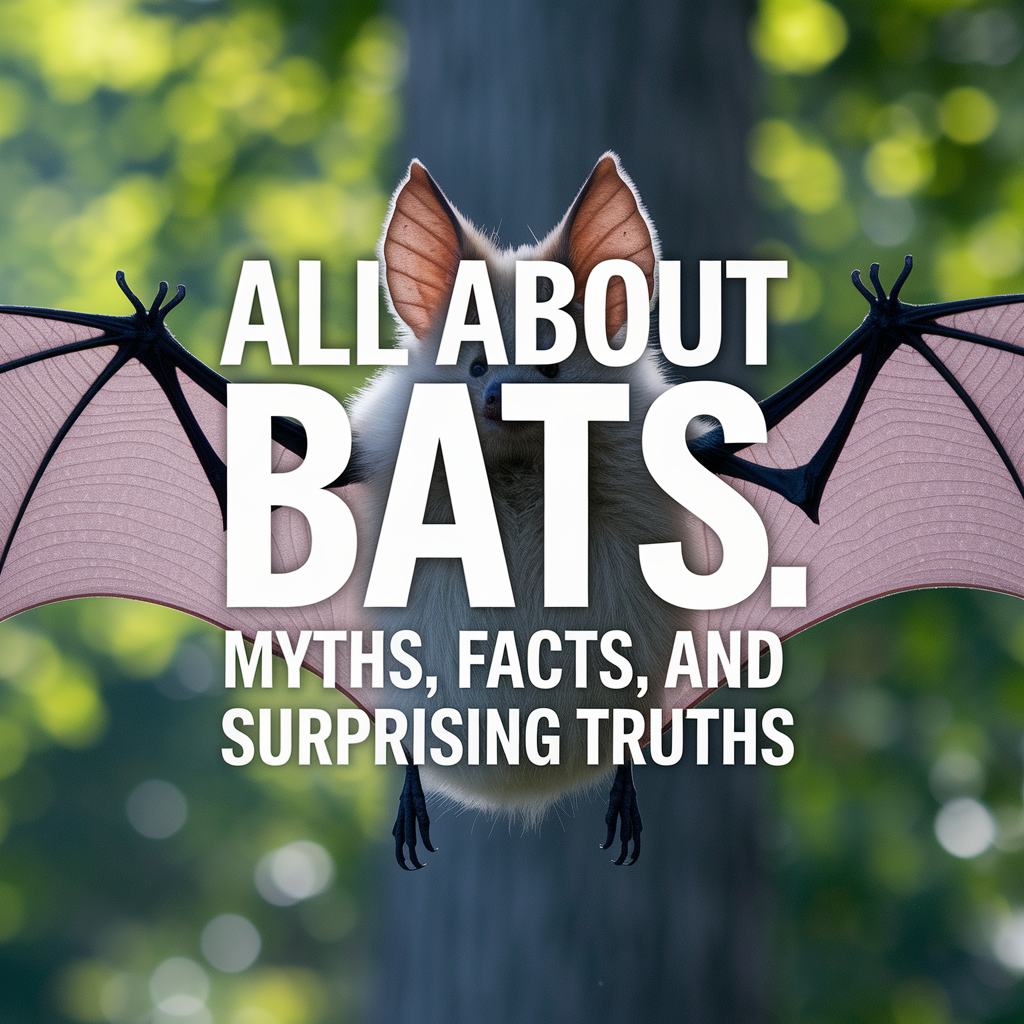
Bats: Creepy Creatures or Nature’s Misunderstood Heroes?
When most folks think about bats, they picture vampires, haunted houses, or that time one got stuck in your attic and chaos broke loose. But the truth is, bats are way more than spooky silhouettes—they’re some of nature’s hardest workers. From pollinating plants to eating mosquitoes by the thousands, bats are surprisingly helpful and kind of awesome once you get to know them.
👀 Are Bats Really Blind?
Not even close. That old saying “blind as a bat” is just plain wrong. Bats do have eyes and can see, especially in low light. But here’s what makes them extra cool—they also use echolocation. That means they send out high-pitched sounds and listen for the echoes bouncing off objects to figure out where they are and what’s in front of them. It’s like having built-in sonar.
🦟 What Do Bats Eat?
Over 70% of the world’s bats are bug eaters. And not just one or two—they can chow down on over 1,000 insects in a single hour. If you hate mosquitoes, you should probably thank a bat. Other bats eat fruit, nectar, and even small critters like frogs or fish. Only a tiny handful drink blood, and we’ll get to those in a minute.
🧛♂️ Are Vampire Bats Real?
Yes, but don’t panic. Out of 1,400+ bat species, only three are considered vampire bats. They live in Central and South America and feed mostly on livestock. They don’t suck blood—they make a tiny cut and gently lap it up. Weird? Yeah. Dangerous? Not really. In fact, the anticoagulant in their saliva is used in medicine to help stroke patients.
What Is Echolocation and How Does It Work?
Echolocation is like nature’s built-in GPS. Bats send out sound waves that bounce off objects and return to their super-sensitive ears. This helps them “see” in the dark with sound. It’s so effective that some bats can hunt tiny insects mid-flight with complete accuracy, even on moonless nights.
Where Do Bats Sleep During the Day?
Bats are nocturnal, which means they sleep all day and party all night. But instead of curling up in a bed, they hang upside down in quiet, dark places like caves, tree hollows, attics, old barns, and even under bridges. Hanging helps them stay out of sight and launch into flight easily when they wake up.
❄️ Do Bats Hibernate?
Many bats do hibernate during the winter, especially in colder areas where bugs are hard to find. During hibernation, their body temperature drops, their heart rate slows way down, and they barely move for months. Some bat species migrate to warmer places instead, just like birds.
Do Bats Lay Eggs?
Nope—bats are mammals, just like us. That means they give birth to live babies and nurse them with milk. Baby bats are called “pups,” and moms usually have just one pup at a time. They keep the little one close, even flying with them when needed. It’s kind of adorable.
🦠 Are Bats Dangerous to Humans?
Bats usually want nothing to do with us. They’re shy, quiet, and not aggressive. The main risk comes from touching a sick or injured bat—like any wild animal, they can carry diseases, including rabies. But the chances of getting sick from a bat are extremely low if you just leave them alone and don’t try to pet one.
Why Do Bats End Up in Attics?
Because our attics are warm, dark, quiet, and perfect for raising baby bats. If they find an opening, bats will happily set up a little nursery colony. The good news? They don’t chew wires or eat insulation like mice or squirrels. The bad news? Their droppings (called guano) can pile up and cause problems if left unchecked. That’s why sealing up holes and calling a bat specialist is usually your best move.
What Is Bat Guano and Is It Really That Gross?
Guano is just a fancy name for bat poop. Sounds nasty, but here’s the twist—it’s actually rich in nutrients and has been used for centuries as fertilizer. That said, piles of guano in your attic? Yeah, not ideal. It can grow a fungus that causes a lung infection called histoplasmosis, so cleanup should always be left to the pros.
🌎 Where Do Bats Live Around the World?
Everywhere. Seriously—except for the coldest corners of the Arctic and Antarctica, bats can be found on every continent. Whether they’re darting through forests, swooping over deserts, or fluttering around cities, these little mammals have adapted to all kinds of environments.
🌸 Do Bats Really Pollinate Flowers?
Absolutely. Fruit bats, also called flying foxes, are pollinators just like bees. In tropical areas, bats play a major role in pollinating flowers and spreading seeds. In fact, plants like bananas, mangoes, and agave (used to make tequila!) rely on bats to thrive. So next time you take a sip of a margarita, thank a bat.
🎥 Why Are Bats Always in Scary Movies?
Bats got a bad rap thanks to Hollywood. Between Dracula, haunted houses, and Halloween decorations, bats have been labeled as spooky for generations. But in reality, they’re gentle, clean, and do way more good than harm. It’s time to rewrite the script on bats—they’re more hero than horror.
🔍 How Can You Tell the Difference Between Bat Species?
There are over 1,400 bat species worldwide, and they come in all shapes and sizes. Some, like the bumblebee bat, are tiny enough to sit on your thumb. Others, like the giant golden-crowned flying fox, have a wingspan over 5 feet! You can usually tell them apart by their ear shape, size, nose structure, and habits—though you’d need to get pretty close (which we don’t recommend).
💡 How Can I Attract Bats to My Yard?
If you want fewer mosquitoes and more nighttime nature vibes, bats are your friends. You can attract them by putting up a bat house—a small wooden shelter mounted high up in a quiet area. Also, avoid using pesticides and keep some night-blooming flowers around to draw in insects (aka bat snacks).
Can You Relocate Bats Without Hurting Them?
Yes, but timing matters. Removing bats during baby season (usually spring and early summer) can separate moms from their pups, which is heartbreaking and also illegal in many states. The best way is to wait until late summer or fall and use humane exclusion methods—like one-way doors—so they can leave but not return.
😱 What Should I Do If a Bat Gets in My House?
Don’t panic and don’t swing a broom. Open all the doors and windows and give it space—it’ll usually find its way out. If it doesn’t, call a local wildlife removal expert. And whatever you do, never touch a bat bare-handed. Even healthy bats can bite if they feel threatened.
🧬 Are Bats Related to Rodents?
Nope! Bats are not flying mice. They’re part of a totally separate order of mammals called Chiroptera, which literally means “hand wing.” They’re more closely related to primates than rats or squirrels. So let’s stop lumping them in with rodents—they’re in a league of their own.
💔 Are Bats in Danger?
Sadly, yes. Many bat species are declining fast due to habitat loss, wind turbines, and a deadly fungus called White-Nose Syndrome. This disease has wiped out millions of bats across North America. The good news? People are stepping up with research, bat houses, and conservation projects to help these little sky ninjas survive.
😴 Do Bats Hibernate or Migrate?
Some bats hibernate, others migrate, and a few do both depending on the weather. In colder areas, bats tuck themselves away in caves, barns, or attics during winter to ride out the cold in a state of torpor (bat-speak for deep sleep). Others, like certain tree-roosting species, fly south to warmer climates. Either way, they slow their metabolism way down to conserve energy.
🦠 Can Bats Spread Disease?
Yes, but let’s break it down. Like many wild animals, bats can carry diseases like rabies—but the actual risk of catching it is super low unless you’re handling one (which you shouldn’t do). Most bats want nothing to do with you and are just out there eating bugs and pollinating plants. With proper respect and no contact, they’re no threat to you or your family.
🍼 How Do Baby Bats Grow Up?
Bat babies are called pups, and they’re born hairless, blind, and totally dependent on mom. Most bats only have one baby per year—twins are rare! Mama bats nurse their young while hanging upside down, and after a few weeks, the pups start flapping their wings and learning to fly. It’s like bat preschool in the sky.
🌳 Why Do Some Bats Hang in Trees?
Not all bats live in caves. Some prefer to roost in trees, under loose bark, in old woodpecker holes, or even in your shed. Tree-roosting bats tend to move around more often and are harder to spot. If you have large, mature trees on your property, you might be providing bat shelter without even knowing it.
🌙 Why Are Bats Most Active at Night?
Bats are nocturnal because their favorite snacks—mosquitoes, moths, beetles—come out at night. Plus, fewer predators are around when it’s dark, and cooler temps help them regulate their body heat. Their amazing echolocation skills also give them a huge edge in the dark, letting them zip around like night ninjas.
🔊 What Does Bat Echolocation Actually Sound Like?
To human ears? Mostly nothing. Bat echolocation calls are usually too high-pitched for us to hear, but some lower frequency clicks can be heard if you’re close. Researchers use special equipment called bat detectors to record and study these calls, which are like built-in sonar systems guiding bats through total darkness.
📏 How Big (or Small) Can Bats Get?
The tiniest bat in the world is the bumblebee bat—it weighs about as much as a penny and can fit on your fingertip. On the other end of the spectrum, the giant golden-crowned flying fox has a wingspan over 5 feet! Whether they’re tiny sky fairies or large gliders, bats come in all kinds of awesome sizes.
🏡 Are Bat Houses Really Worth It?
Yes—if you’re serious about helping bats and want fewer bugs in your yard. A properly placed bat house gives bats a safe, warm spot to roost and raise their pups. Place it at least 12 feet high in a sunny spot with minimal nighttime light. Just be patient—it can take a year or two before they move in.
What’s the Deal with Vampire Bats?
They’re real, but not the way movies make them out to be. There are only three species of vampire bats, and they all live in Latin America. They drink blood from cattle or birds—but they don’t suck blood like Dracula. They make a tiny cut and lap it up. And fun fact: their saliva contains anticoagulants that scientists are studying to help prevent blood clots in humans.
🧪 How Are Scientists Using Bats in Research?
Bat biology is being studied for everything from disease control to flight mechanics. Their echolocation is helping researchers develop better sonar and navigation systems, and their immune systems are helping us learn how to fight viruses. Bats might just help cure the next big human disease—and that’s no exaggeration.



